I really did not want spend my time writing a waisted (sic) article, but why not?
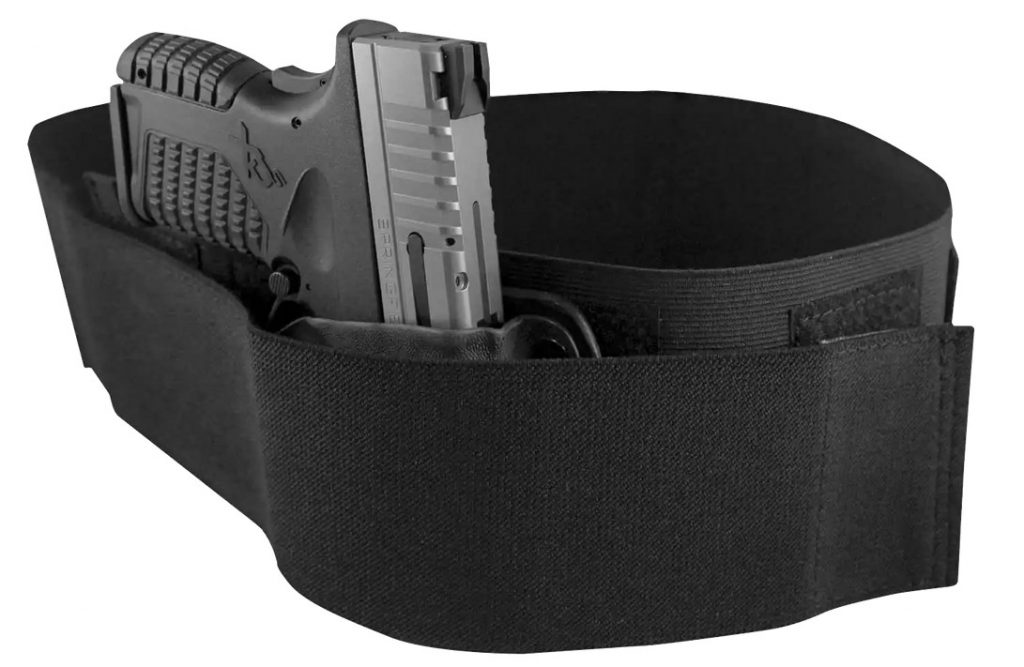
How would you like an IWB holster for your favorite EDC that you could position for strong-side, appendix, or cross-draw carry just by repositioning it? How would you like an IWB holster that you could carry a couple of spare mags along with your EDC and other items, like a couple of Slim Jim snacks or other snack to satisfy a quick craving? Well, do I have a product for you, Bippy…the Belly Band Holster.
There are plenty of belly band holsters on the market with some being good and well-thought out, and there are those not so good and well-thought out. This article is meant to inform you of both and provide some tips in what to look for when considering a belly band holster. This is not an all-inclusive article but just something for consideration.
First up, belly band holsters are versatile but not for everyone. I am going to go into the pros and cons of belly band holsters in general and then try to focus on some points that you need to consider before you ‘belly’ up to the bar to this particular holster type. Some points will be obvious while other are not so obvious.
What is a Belly Band Holster?
A belly band holster is a large elastic band (or not) that is big enough to cover the hips. Secured with the use of a (usually) hook n’ loop material, the holster molds itself to the body. This type of holster comes in a wide array of colors but the most popular ones are white, tan, and black. Additionally, it is available in a wide array of sizes in order to suit and fit all body types. In most, but not all cases, a single belly band holster can accommodate several different sizes of pistols and revolvers and may or may not include separate pockets for spare ammunition or whatnot.
What to Look for in a Belly Band Holster?
When looking for a belly band holster, there are some considerations to think about. Among all these considerations are as follows:
- Flexibility
- Accessibility
- Organization
- Comfort
- Fit
- Trigger Guard and Safety
- Retention
- Quality
- Portability
- Attachments
- Desired position
Let’s go from top to bottom and read a bit.
Flexibility
Belly band holsters are made using a stretchable material. Because of this, they are able to hold all types and sizes of guns. The pocket of the belly band holster that holds the firearm, however, should be sized to the firearm. With that said, I have a belly band holster that will work with virtually all Glock and Springfield XDm pistols from sub-compact to the long-barreled versions since, essentially, that body of the pistol is what’s being secured; The barrel and grips length really doesn’t matter. I also have one that will work with any variation of the 1911 (Government, Commander, or Officer).
Accessibility
Accessing your firearm from a belly band holster is much better than doing the same from an ankle holster. As with any IWB holster there may be some effort involved when needing to access the firearm. A shirt (or additional outer garment) may have to be lifted and positioned so as not to interfere with the draw. I have a ‘supported’ belly band holster that I use as a deep-concealment should rig when I carry ‘small’ and this requires the unfastening of a shirt, which is why I usually wear a shirt with snaps rather than buttons when I use this holster.
Accessibility, however, is more than just where your EDC is positioned on the body. Think about grabbing the butt of your firearm and if there anything that would interfere with doing so. The belly band may be worn above the beltline or even with the belt-line. What is there to interfere with you getting a full hand of butt (You can stop giggling now, children!)? How much clearance is there between the holster pouch and the grip of the firearm?
If the mouth of the holster pouch is not supported, chances are that the weight of the firearm and gravity will cause the grip to slide into the pouch material possibly even to the point that you can no longer grasp the butt of the firearm without a contorted effort (like that shown below).
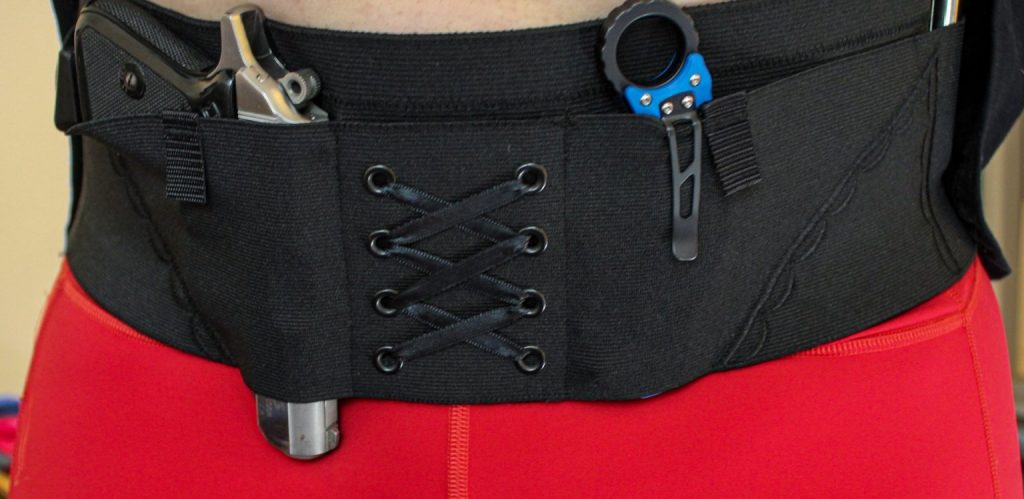
You may also must consider clothing in the mix. The belly band may be worn even with or just above the beltline inside the pants. You need to consider the position of the belly band in relation to the outer wear you are using to cover the band (belted trousers, sweatpants, shorts) to ensure that you have clear access to something that is going to protect what is vital to you…like your life.
My OWB holsters must have enough grip to holster clearance to accommodate a full-fingered grip on my EDC. Why would I not demand the same for a belly band holster?
Organization
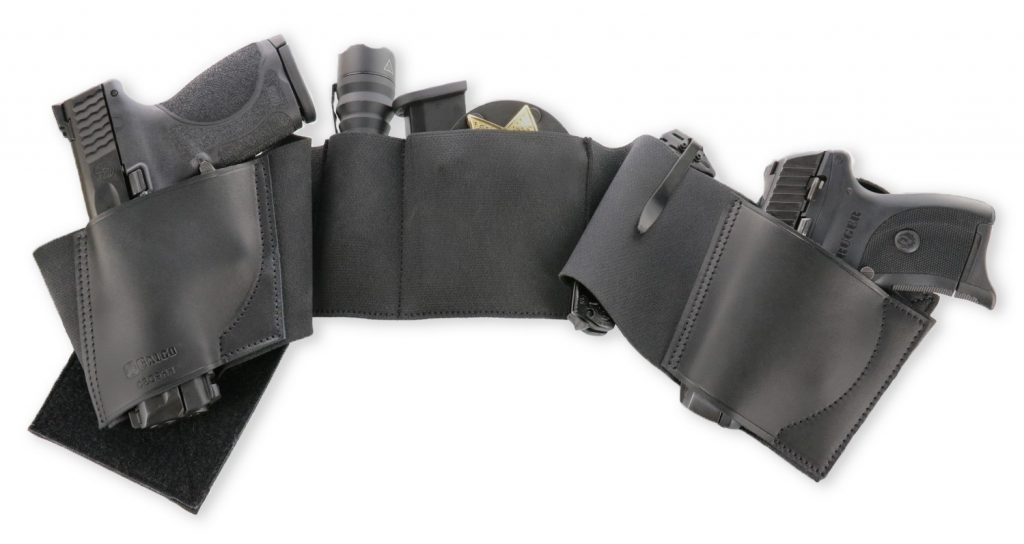
This part relates also to ‘Compartments’ (or ‘pouches’ if you will). How do you need to organize what you carry? What will you be carrying in the belly band? Just because this type of holster starts with a “B” does not mean that it is a “Bat Belt.” I have seen many for sale that hold cell phones, keys, wallets, lipstick tubes, handcuffs, flashlights, expandable batons, and more. Think about for what purpose is the belly band for you. LEOs may need more pockets than you and me when they carry off-duty or undercover, but as a civilian I need to keep it simple and I need to keep things as normal and familiar to me as possible. Think about how you need to organize the belly band and what you need to organize it with and the position within the belly band of each item. Personally, I like my belly band holster to house my EDC and one or two spare magazines. The rest I can handle externally.
Comfort
The beauty of the belly band holster is that it is inherently comfortable even when worn tight (as it should be worn). The uncomfortable part usually comes with what is stored in the pouches and how those items interact with the body. Depending on the width of the belly band, things like magazines may dig into the body. The firearm may dig into the body. Some belly bands have sweat shields that help mitigate the intrusion of the butt of a firearm into your body. I am used to the butt of a 1911 snugged tightly into the side of my body with only a T-shirt between me and it. However, that may bother you and is something to consider when shopping for a belly band rig.
Belly bands are created with different materials and when worn against skin may create an adverse reaction. I always wear a T-shirt and this alleviates any reaction between my body and the band. Pay close attentions to belly band materials and how you want to wear the band to avoid any allergic reactions to band material.
Fit
Loosely referred to in Comfort was fit. There are two considerations for fit: body and holster.
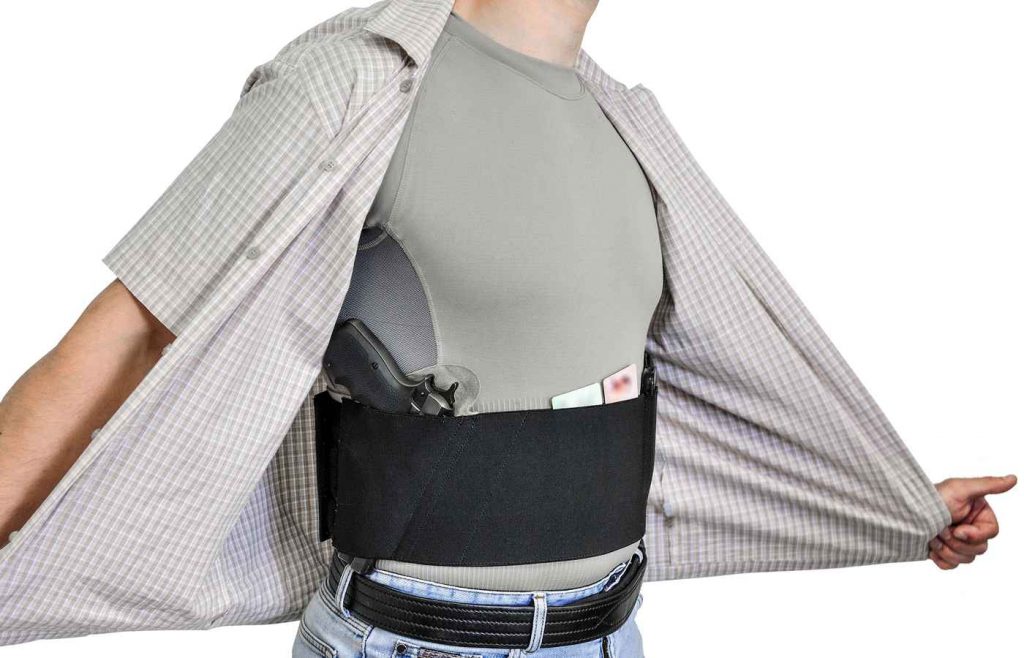
For bodies, bodies are not created equal – in weight, shape, and size. Most web sites that sell belly bands provide a guide in determining what size of belly band to order and most sizes are determined by where you are going to wear the unit…above the hips near your belt line, around the belly, or even as a pseudo shoulder holster. Belly bands are intended to fit tight and are made from stretchable material to accommodate that fit. The more width to the band the less likely to “stretch out’ over time.
For holsters, no gun is created equal – not only in power but in weight and size as well. When choosing a belly band holster, you must make sure that it perfectly fits your firearm. In most cases, the holster is simply a double-stitched outline where you house the firearm. Lately, however, I have seen a few manufacturers that provide either Kydex or other material “shells” that are tailored to fit specific firearms. Some of these shells can be removed/re-positioned and some are fix mounted. Some allow for slight changes to holster angle (negative cant and positive cant) to best fit your needs and some are specific to a draw-type (strong-side, appendix, or cross-draw.
Trigger Guard and Safety
For your safety, no matter how perfect a belly band holster may look, if it does not conceal your trigger guard, then remove it from your list of prospects, or if you have one, remove it from your carry considerations. Safety should always be your priority.
Normally, with few exemptions, the belly band material will cover the trigger guard. And just as normally, the material will prevent you from inadvertently getting your trigger finger (or anything else) inside of the trigger guard and against the trigger.
With few exceptions, the material used to cove the trigger guard will collapse when the firearm is removed.
Retention
I have many stories about me being sent to retention while in school. Oh, wait! I meant retention and not detention.
I have seen many examples of belly bands with retention straps and even thumb breaks for securing the firearm. While I believe retention straps and thumb breaks are essential with OWB holsters carried openly and shoulder holsters, they have no place on a belly band holster.

Let’s see, first you may need to lift outer clothing out of the way, then you have a pistol that has settled into the holster material that keeps you from getting a good grip on the firearm, then you must remove a strap to remove the firearm! No, thank you. Unfortunately, a belly band holster with a retention strap is removed from my list even though I may like the design, pouch placement, material, etc. I need to remove any obstructions that would prevent me from getting to my PDA when I need it, as you should.
Retention straps can also interfere with holstering the firearm. There is a highly-likelihood that the strap will get into the trigger guard unless it is held out of the way, in addition to clearing any clothing from the path, with one hand while the other busies itself trying to holster the firearm…and that just while initially setting up the band for wearing. Imagine yourself doing that in a stress situation or even a time at the range drawing and holstering.
Mentioned previously, belly band holsters, with few exceptions, collapse after the firearm is withdrawn from the holster. With very few exceptions (I will name them later) does holstering in a belly band holster not require both hands.
I have found that most of my belly bands will secure the firearm with simple tension from my body against the material or additional pressure from a belted trouser against the material, with maybe the exception of doing cartwheels across the dance floor. At 72-years young, my gymnastics consist of getting up from a seated position.
Quality
Obviously, quality is a factor in purchasing/wearing a belly band holster as it is with any holster. You may be able to save money if you buy a cheap belly band holster, but doing so may cost you frustration and more money down the road. However, a higher cost does not guarantee anything except that you have more out of pocket expense. The cost per benefit ratio must be examined.
Portability
Belly band holster are highly transportable, some more than others. Not mounted they can be rolled up into a relatively small space until they are needed. It may be normal for you to change clothes throughout the day, and need to switch to a different type of holster. Or, you just need a means to deep-carry your PDA on a daily basis. A belly band holster that can conceal your firearm effectively and discreetly can do just that.
Attachments
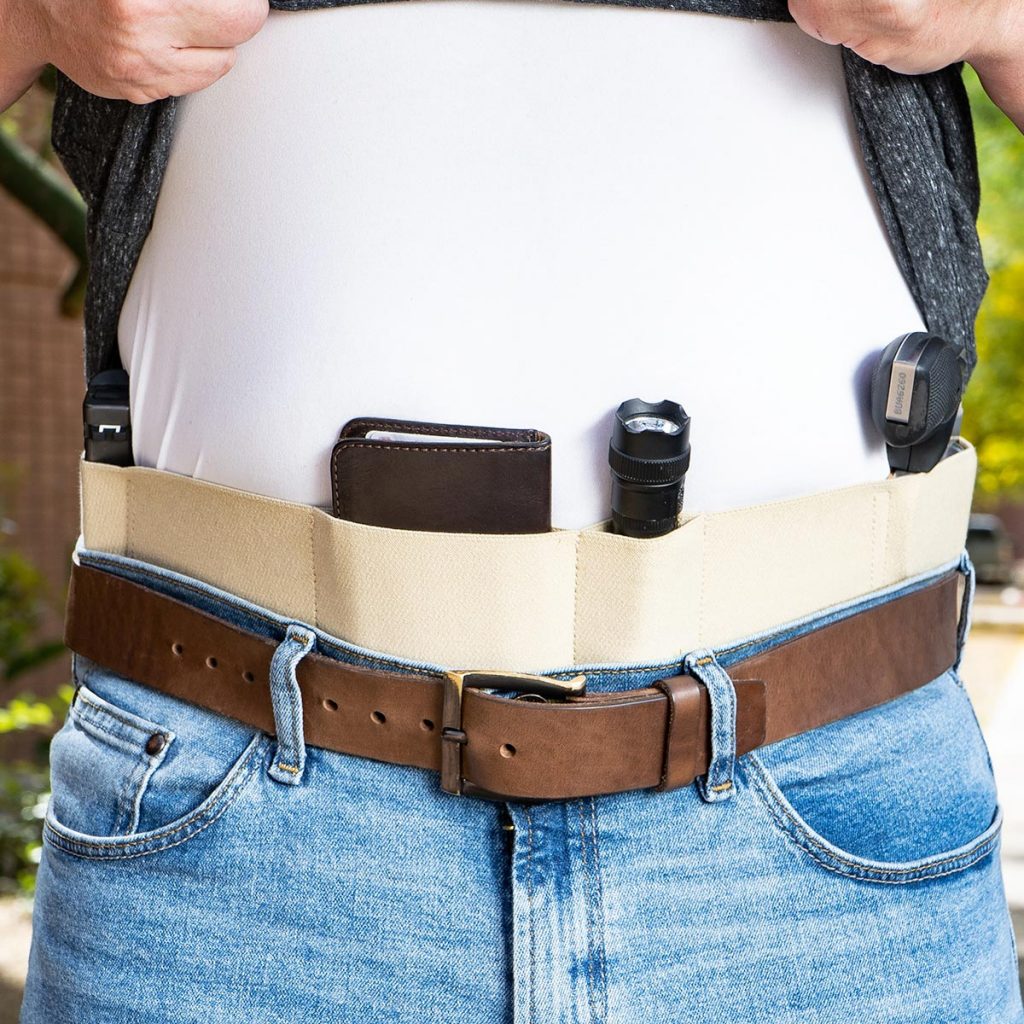
Attachments in a belly band holster come int the form of pockets (or pouches, if you prefer). As I mentioned earlier in this article, I have seen belly band holster with all types and sizes of pocket options. I prefer to keep things simple; One pocked for firearm, and two pockets for spare magazines. All other ‘accessories’ I carry separate from the belly band and most of which are in a pocket in my trousers or my normal ‘photo’ vest that serves as my ‘man-purse’ to carry those other items (including an actual camera should I feel the need) like my cell-phone, ear-piece, wallet….
Desired Position

As was mentioned, belly band holster can be positioned so as to position the firearm (and accessories) as you want it, strong-side, appendix, cross-draw, no matter.
The belly band holster may be designed specifically for these carry positions or can simply be rotated to accommodate your desired position. The attachment point (enclosure) where the ends are attached to each other may be to the front, the rear, or the side after adjusting the position of the holster. It may also be positioned low in the pants-line, across the stomach, or even just below the chest-line in a cross-draw position. (I have seen these advertised with over the shoulder support straps and the word ‘Tactical’ used in the description of. I call them the ‘Male Brassiere” holster.) The belly-band holster is very adaptable in that respect.
Honorable Mentions
There are a couple of belly band systems that I would like to mention and will be looking into for later articles.
CrossBreed One Modular Belly Band Package
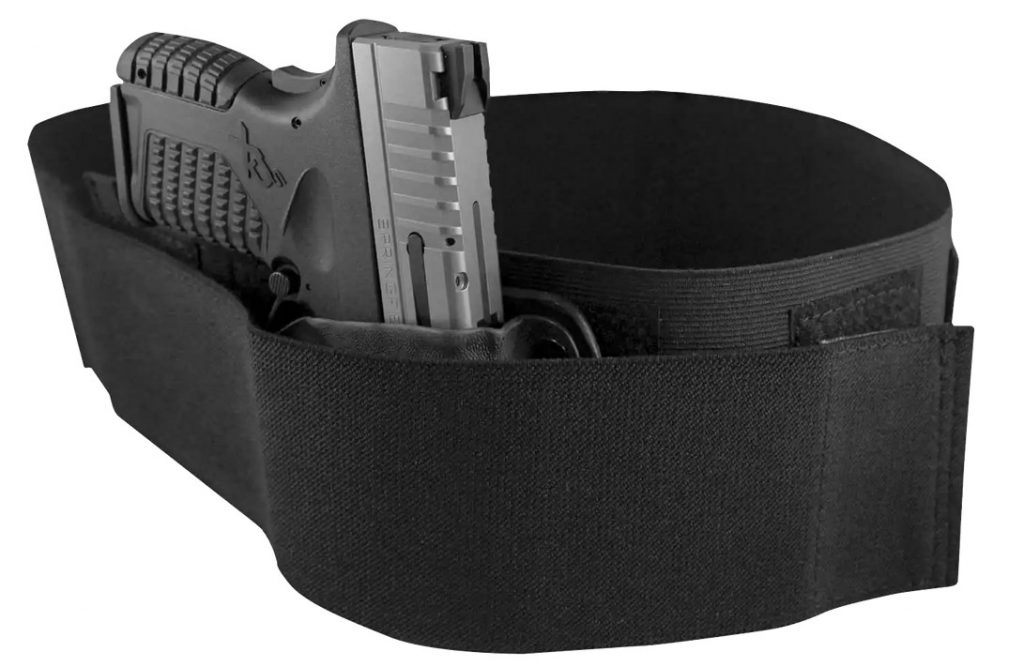
The following is sourced from CrossBreed Holsters:
Sometimes your active lifestyle means it’s difficult to carry your firearm and still be on the move, but not anymore. The Modular Belly Band by CrossBreed Holsters is designed with movement and security in mind.
The Modular Belly Band features a comfortable and reliable elastic band. The stretchable band snugs up securely to any body type or shape, offering you the perfect platform to secure your firearm. The band can be adjusted to various heights or draw positions giving you the control to find where the holster is most comfortable for YOUR body.
What would the Modular Belly Band be without the classic hand molded pocket? The pocket is made much like our SuperTuck and hand molded to the specific firearm giving you the perfect retention. Simply Velcro your Modular Holster in place and stretch the elastic band over top to secure and VOILA! You have the perfect active lifestyle setup.
The elastic band also features a sewn backup magazine or flashlight pouch, and hook and loop accessory pouch for smaller cell phones or accessories.
Leather Options: Black Cowhide, Natural Horsehide
Kydex Options: Standard Black, FDE, Sniper Grey, OD Green
This carry system is great for firearms such as:
- Beretta Nano
- Colt Mustang
- Glock 17
- Glock 26
- Kimber Micro 9mm
- Ruger LC9
- Sig P320
- Sig P365
- Smith and Wesson Shield
- Springfield XDs
- Walther PPS M2 -Breed
View the total list of firearms this unit fits at: https://www.crossbreedholsters.com/modular-belly-band-package.html
Alien Gear Low Pro Belly Band Holster
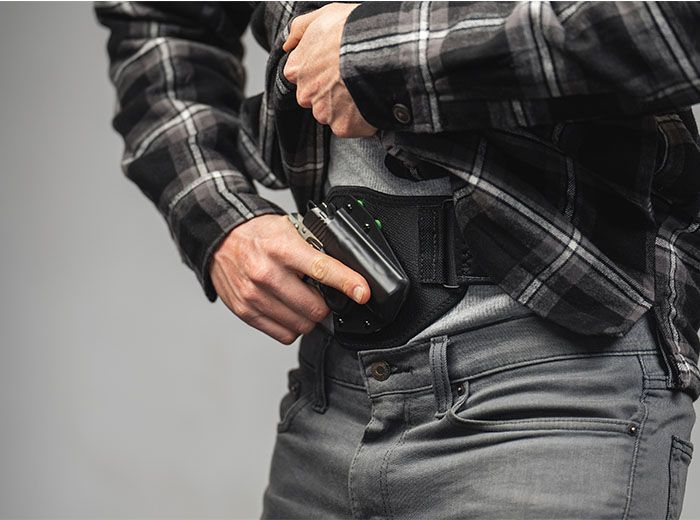
Very interesting concept. The belly band is fully adjustable, breathable, and stretchable unit that incorporates an integrated holster for the firearm. The holster unit is canted to the rear to accommodate strong-side, appendix, or cross-draw carry.
View the product video at: https://www.youtube.com/watch?v=hJjxx9BAC88&t=4s
There is also a video that covers the Low Pro and the Sport Tuck that you will be introduced to next. You can view this at: https://www.youtube.com/watch?v=h_4L72ccK7A
Alien Gear Sport Tuck Belly Band & Holster Bundle
Essentially, this is a holster purchase with a belly band bundled in.

The belly band has integrated inside loops that is used to attach an Alien Gear holster (Alien Gear ShapeShift 4.0 IWB Holster or Alien Gear Cloak Tuck 3.5 IWB Holster (Inside the Waistband)). This setup allows the flexibility of wearing the AG holster IWB and clipped to trousers (normal carry) or attaching to the belly band for wearing with sweatpants or other non-belted clothing that would not otherwise support a firearm.
The band is not stretchable as is with most other manufacturer’s models.

Information regarding the holster is readily available, but information regarding the belly band is not. I do believe that the belly band is the same as used with the Alien Gear Low Pro Belly Band Holster, but without the holster integrated into it.
View information about it at: https://aliengearholsters.com/belly-band-holster.html
Almost Last Words
Most gun owners can agree that belly band holsters are very useful in concealing the firearm while staying attached to the owner’s body. Some advantages are included below:
- They are perfect for any activity the owner may undergo, for instance, running, hiking, jumping.
- The holster is designed in which the gun will never jostle out because of these physical activities.
- Gun manufacturers saw the need for the belly band holsters as they can be worn under light clothing for men and women, and if the shoulder or waistband holster isn’t good enough to conceal it.
- Not all holsters are good for any wardrobe. Take for example the shoulder holsters. To function as a concealed carry, the person has to wear a jacket. But wearing jackets on a hot summer is out of the question.
- Gun owners have a problem with buying different holsters to suit the model of the gun they’re using, but this issue is negated by a belly band holster as you can insert any size of a handgun into its pockets.
- Belly band holsters are indeed multipurpose, from storing handguns to extra ammunition or flashlight.
- When I wear a ‘standard’ IWB holster, I normally must wear suspenders to help support the load as my body no longer has that ‘youthful’ figure (whatever that means). I also carry a modified Remora double magazine pouch with two spare magazines for the 1911 (or other magazines depending on the pistol carried). With a belly band holster, suspenders are no longer needed. The tension of the belly band holster is enough to keep it in place and no weight is placed on the trousers. It is a plus if the band that I am wearing at the time has a magazine pouch, otherwise I revert to my modified Remora.
When it comes to disadvantages, belly band holsters have a few.
- First is that the band material isn’t up to the job of wicking sweat, so if you’re not careful, you can make your gun rust due to moisture. If that would be the case, remember to wipe the sweat off your gun after a hard activity.
- Second is that the holster is made of band material and should always be tight at the waist area. It may cause people discomfort and itchiness especially is the fit is not right. Others have a solution of wearing an undershirt and then the belly band holster but during scorching days, it’s not ideal to have many layers of clothing.
- Third is the belly band holsters require an outer garment. I like wearing shirts with snaps rather than button whenever I wear a belly band rig (or a deep concealed shoulder holster). The reason is that I tend to have shirts one size larger, and therefore longer, than what I would wear when not carrying a firearm, which means I wear larger and longer shirts more than not. A long shirt is more difficult to raise above the level of the firearm than simply unsnapping snapped enclosures. I have several shirts that look like they have buttons, but are actually snaps.
- Belly band material stretches over time. Like magazine and recoil springs, it is the use that wears them out.
In Closing
As I stated at the beginning of this article, belly band holsters are not for everybody. I have used them, in one form or fashion, on and off for at least a decade…and they served their purpose well.
While I can recommend their use, I cannot recommend any specific brand or type, although I do have my preferences and have a few yet to research. My wear style and other factors may not fit yours and I leave it up to you to investigate on your own even if a belly band holster is right for you to wear.
Be aware that compared to ‘normal’ IWB holsters, a belly band holster may take a lot more effort to find the one right for you. Included in my storage case for holsters are belly band holsters and fanny pack holsters that came at an expense to me. Hopefully, I have helped to reduce that expense for you through this article.
Resources
There are many resources on the WWW. Simply input into your search engine Belly Band Holsters or the same in YouTube to receive an overload of information.
Attributions
I must attribute https://blog.gunassociation.org/best-belly-band-holster/ for some of my material. I did e-mail to receive permission to reprint material, but that went unanswered. So, it is only right to provide an attribute to serve as recognition of their effort and my using some of their material.
![]()

